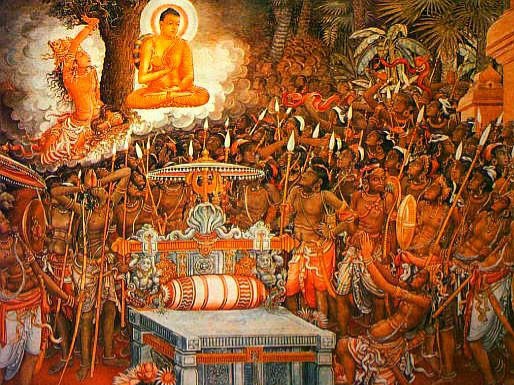THE MIRACLE ON BAK POYA: THE BUDDHA AND THE NAGA KINGS
The air in Nagadipa hung thick with tension.
A low rumble, not of thunder but of discontent, vibrated through the island. Two Naga kings—Mahodara, proud and established, and his nephew Chulodara, ambitious and fiery—stood poised on the brink of war.
Their quarrel? A throne.
But not just any throne—this one shimmered with embedded jewels, a symbol of power and prestige.
Both kings, surrounded by their loyal followers, were ready to unleash a torrent of fury upon the other.
The very waters around the island seemed to churn with the impending conflict.
The peaceful rhythm of the waves was disrupted by the agitated movements of the Naga people, their scales glistening with unease.
It was a moment teetering on the edge of chaos—a tragedy waiting to unfold.
But on that sacred Bak Full Moon Day, as the moon bathed the island in its soft glow,
a different kind of power descended.
From the heavens, a figure of serene radiance appeared—the Buddha—his presence a beacon of tranquility amidst the brewing storm.
As he hovered in the sky, a hush fell over the warring factions.
First, a deep, all-encompassing darkness enveloped the island, causing the Nagas to recoil in awe—and perhaps a touch of fear.
Then, as suddenly as it had descended, the darkness shattered, replaced by a brilliant golden light emanating from the Buddha himself.
It was a spectacle that pierced through their anger—
a divine vision that commanded attention and reverence.
The two Naga kings, their animosity momentarily forgotten, gazed upwards—
their hearts humbled by the sight.
Then the Buddha, his voice filled with compassion, began to speak.
He spoke of the futility of hatred,
the ephemeral nature of worldly possessions,
and the profound peace that comes from understanding and harmony.
His words, like a soothing balm, calmed the agitated minds of the Nagas.
He showed them the interconnectedness of all beings,
the suffering born of clinging to ego and desire,
and the path to liberation through wisdom and compassion.
The gem-studded throne—the cause of their bitter dispute—suddenly seemed trivial before such profound truth.
Touched by the Buddha’s teachings, both kings felt their anger melt away.
The desire for conflict faded, replaced by remorse and a yearning for peace.
They laid down their weapons, their hearts now united in shared understanding.
As a gesture of deep gratitude, Mahodara and Chulodara offered the magnificent throne to the Buddha.
But the Enlightened One, detached from worldly attachments, gently declined.
Instead, he asked them to enshrine it—
so it may serve as a reminder of his visit and his message of peace for generations to come.
And so, on that sacred Bak Full Moon Day, the gem-studded throne found its resting place at the Rajayathana Stupa,
built on the very ground where the Buddha quelled the flames of conflict.
The Nagadeepa Purana Rajamaha Viharaya stands today as a testament to this miraculous moment, a beacon of peace and harmony.
To this day, on Bak Poya, devotees gather at this sacred site,
remembering the day the Buddha brought peace to the Naga kings
and gifted the world a timeless message of understanding.

